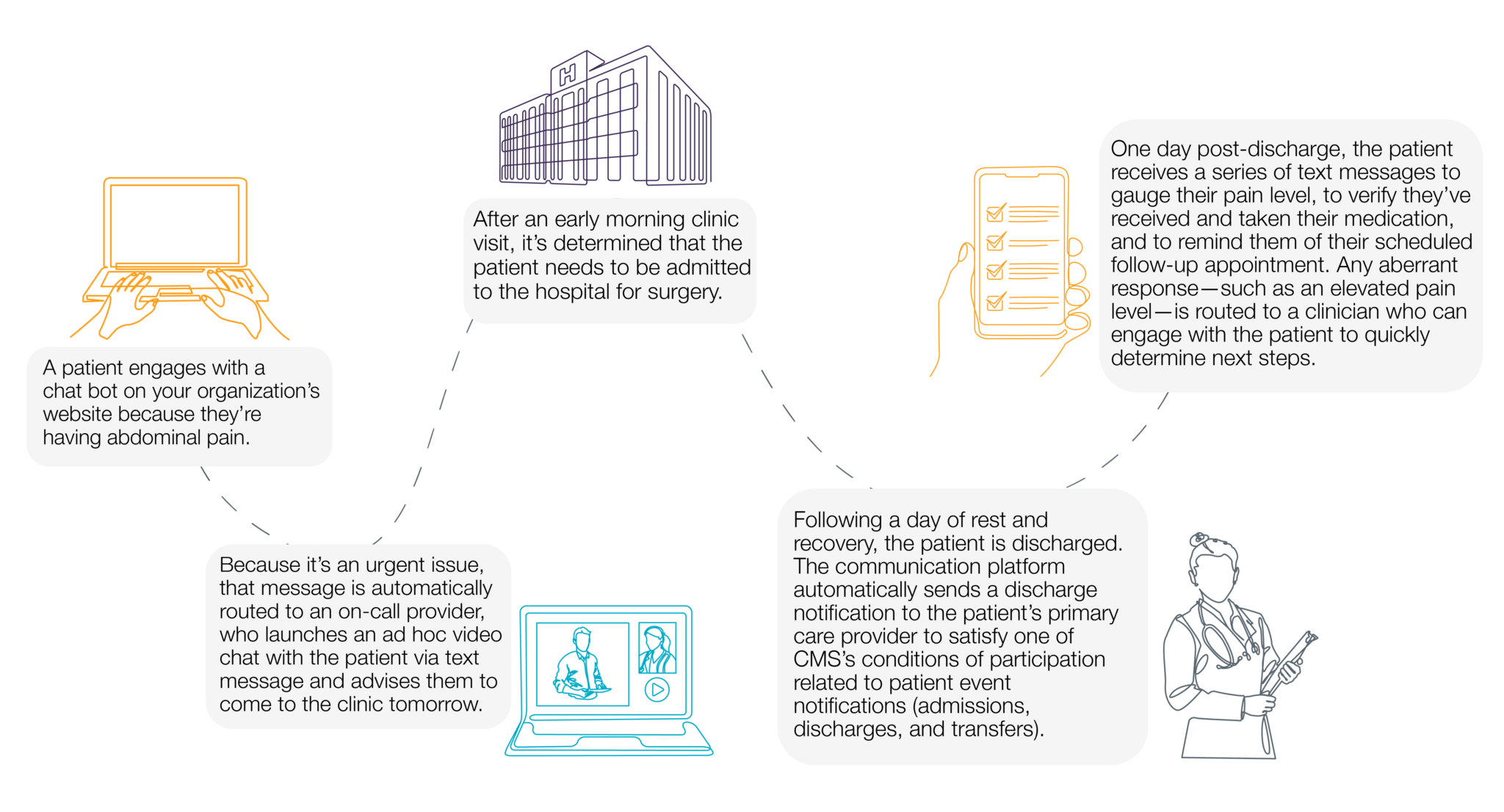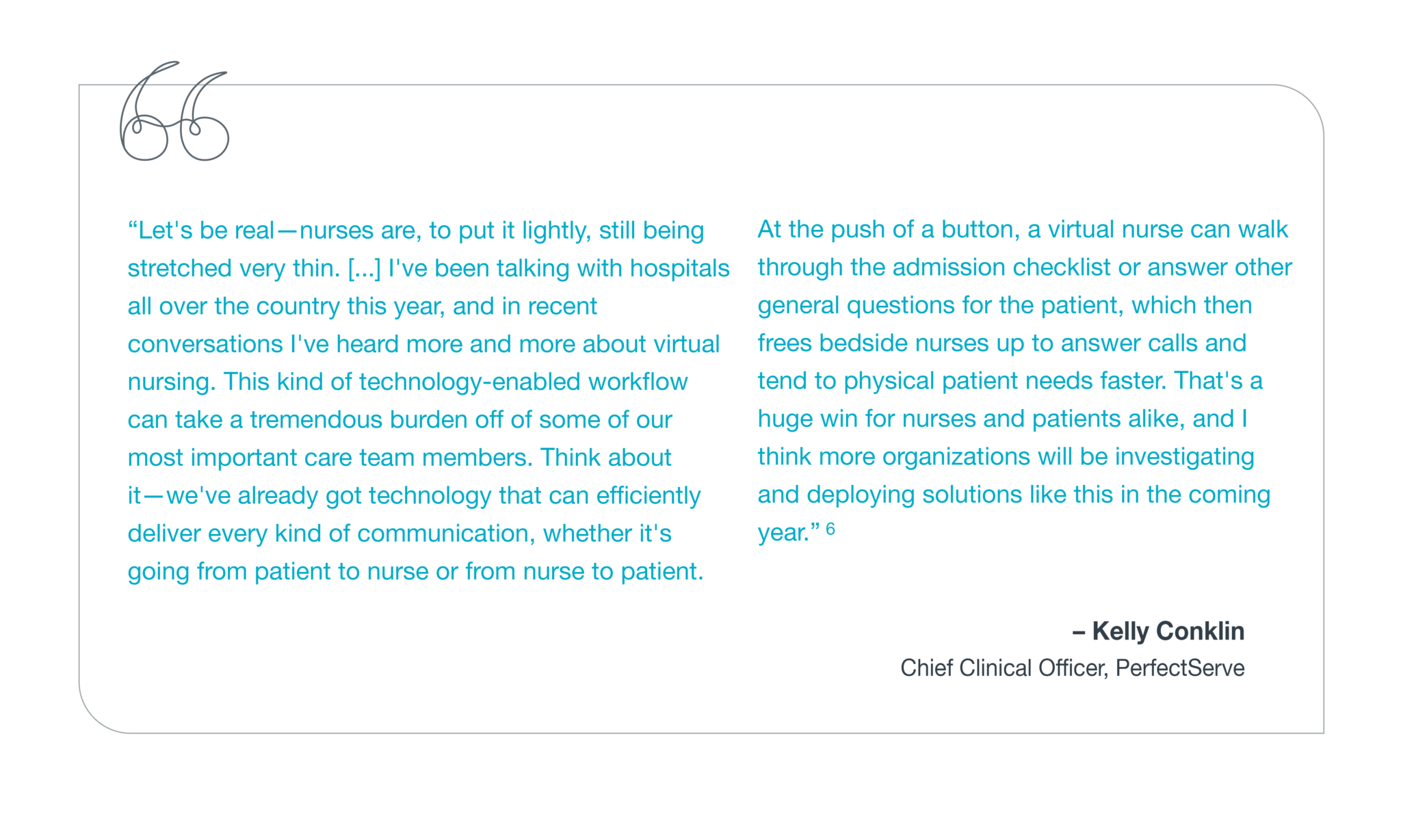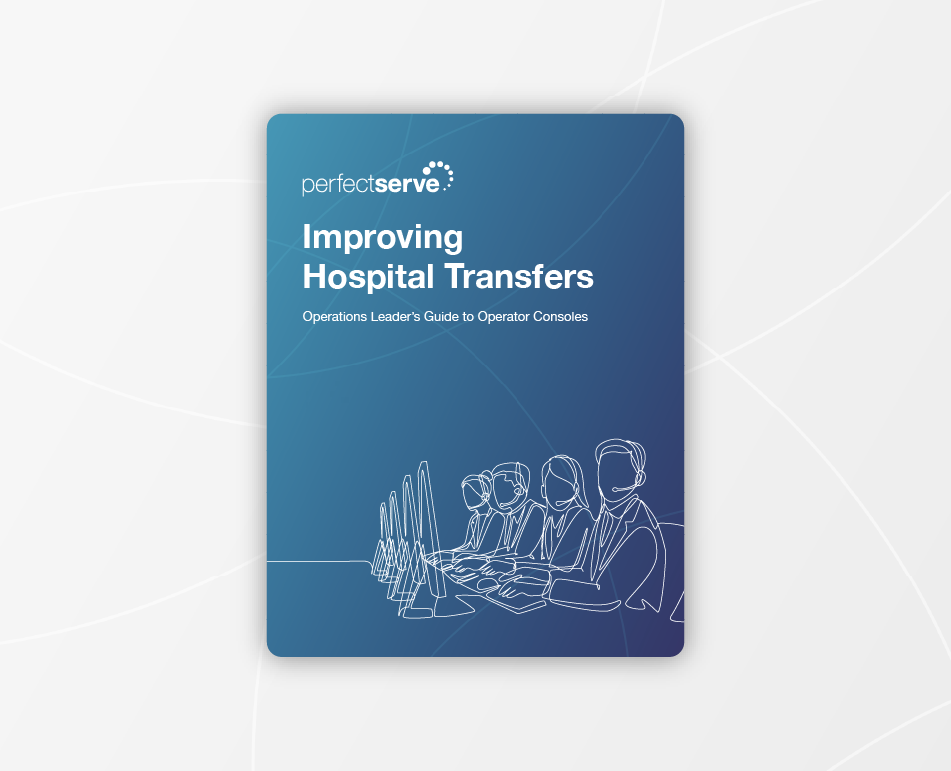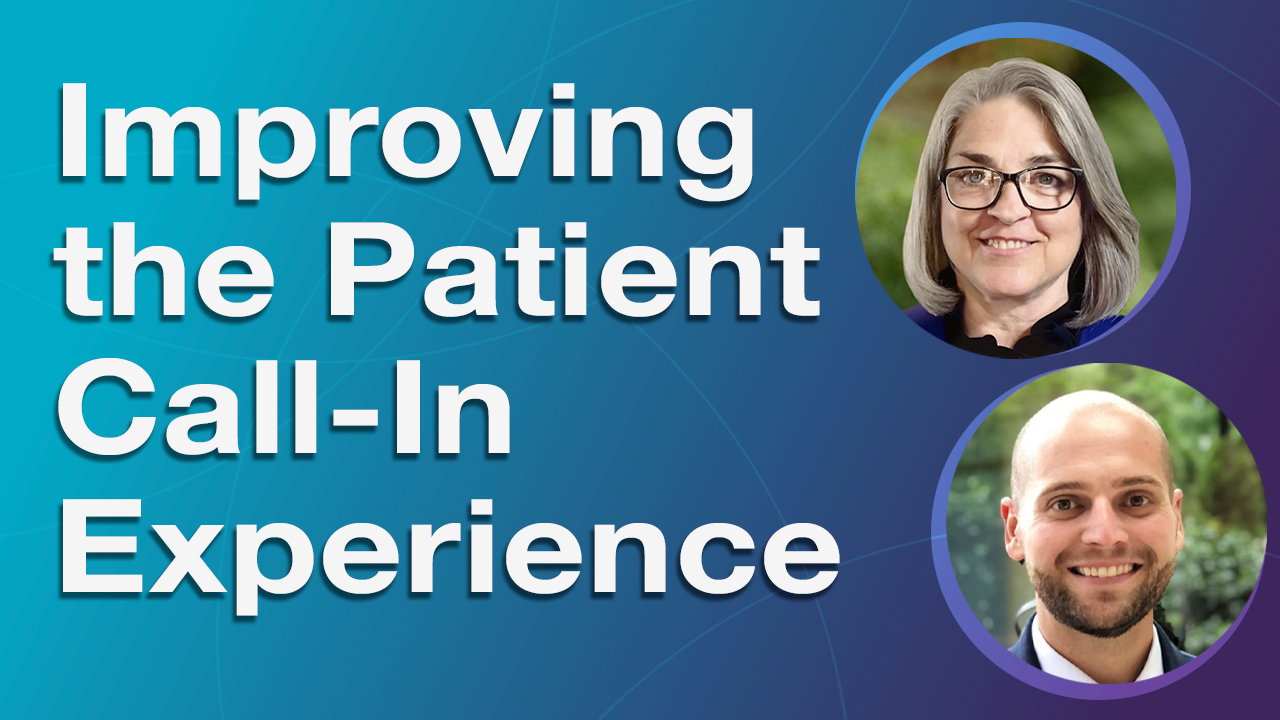Clinical Communication in 2023: Trends and Predictions
TABLE OF CONTENTS
The clinical communication market is no stranger to change. The first solutions in this space solved a basic (but important) need for secure, HIPAA-compliant messaging. Since then, the scope of their impact has grown by leaps and bounds.
In its “Clinical Communication Platforms 2021” report, which uses data compiled from thousands of interviews with healthcare professionals, KLAS noted that all respondents said clinical communication solutions “improved efficiency overall,” with the top outcome being improved clinician collaboration. It’s an encouraging trend that underscores the impact of effective care team communication, but as technology and the healthcare industry at large continue to evolve, there’s so much more that clinical communication platforms can accomplish. And with many ripple effects from the pandemic still being felt, the circumstances under which these platforms will develop and expand have shifted a bit.
We asked some of PerfectServe’s brightest minds—folks who have deep clinical and/or health IT experience—for guidance and came up with a brief list of trends, functionality, and market forces that will define the clinical communication landscape in 2023.
Consolidating Communication Channels
In a recent Health IT Answers article,1 Dr. Rodrigo Martínez, PerfectServe’s Chief Medical Officer, touched on another important trend: consolidation of communication channels. It makes no sense to paraphrase the expert when he said it so eloquently, so here’s what he said in full:
“Most health systems today still have a very siloed approach to communication investments. I like to break the current landscape down into five categories:
- Outbound marketing campaigns (for things like appointment reminders)
- Digital front door infrastructure (websites, chat bots, mobile apps as a portal into the system)
- Secure messaging (the modality by which care teams communicate about patients within the system)
- Telehealth (systems that support remote/video interactions with patients)
- Operational communications (pagers, paging systems, telephone systems used to handle inbound referrals/inquiries)
All of these channels are on a bit of a collision course as system leaders look to consolidate their tech stacks. In 2023, many will be looking for more extensible communication solutions that unite these functionalities, span the entire care continuum, and make it easier for clinicians to accomplish the day-to-day tasks associated with providing care. With ongoing budget challenges, staffing shortages, and elevated burnout levels, expensive point solutions can no longer cut it.”
In 2023, clinical communication systems will play a central role as healthcare organizations examine communication silos to streamline and integrate their operations. Like others, PerfectServe takes this challenge of interoperability very seriously, which is why our list of supported clinical integrations has grown to over 200.
Integrating the Call Center
Bringing the healthcare call center into the 21st century has long been a goal of PerfectServe Chief Product Officer Ben Moore. He was recently interviewed by Healthcare Contact Center Times for a piece published in their December 2022 issue,2 which starts as follows:
“Even though hospital call centers exist to serve patients, that’s not their only purpose. A well-run hospital call center can decrease the manual burden on operators, reduce burnout for clinicians, and eliminate communication errors.
But there’s one problem: A lot of call center technology is stuck in the 1990s.
Ben Moore […] thinks it’s time to modernize the call center and connect the center (and its operators) with a broader clinical communication ecosystem to support changing patient expectations.”
Why is this important? It’s simple: Call centers are the backbone of effective communication within hospitals, as well as for patients and outside personnel. As more routine calls are automated, these call centers are quickly evolving to become all-encompassing patient engagement centers.
If your call center is powered by dated on-premise technology, integration with other key systems—whether related to communication or other functions—is exceedingly difficult or even impossible. The siloed nature of these legacy systems often leads to long delays, missed calls, games of phone tag, confusion, and an otherwise unpleasant experience for anyone attempting to reach the call center, from patients and their family members to referring providers.
As the market shifts away from on-premise solutions, 2023 will see more adoption of cloud-based call center software that lives inside of, or can be easily integrated with, a broadly deployed clinical communication solution. Going to the cloud gives agents work-from-anywhere flexibility, and giving them ready access to all of the functionality of a messaging platform used by the clinicians they’re often trying to reach ensures better communication, better cycle times, a better patient experience, and better call center outcomes all around.
Wanted: Efficient Workflows
We’d be remiss if we didn’t start by addressing ongoing burnout and staff shortages. A significant number of frontline clinicians who bore the brunt of the pandemic stress have left the healthcare space entirely, with some estimates indicating that as much as 20% of the healthcare workforce has been lost over the past few years.3 Provider organizations have experienced tremendous financial strain trying to make up for this void in personnel while maintaining clinical operations.
With less staff, higher stress levels, and financial challenges in play all at once, clinical communication systems will play a key role for these organizations in 2023: facilitating more efficient workflows for clinicians. This has long been one of the major purposes of these solutions, so the goal itself isn’t brand new, but the emphasis on creating efficiencies has risen to a new level of importance in the face of persistent burnout and chronically understaffed facilities.
By automating tasks, alleviating delays, making it easier to coordinate patient care, and even supporting integrations with things like provider scheduling solutions, clinical communication technology is set to become a primary source of relief for clinicians who are trying to do more with less. Some examples:

We could go on, but these are just a few prime examples of how clinical communication solutions can transform clinical workflows to improve job satisfaction for clinicians while facilitating patient care of the highest quality. Be sure to read more about PerfectServe’s recent partnership with Bon Secours Mercy Health and its partnership with Hospital for Special Surgery to automate the delivery of critical lab results.
Communication Ecosystems for the Entire Care Continuum
Even though COVID-19 has shifted to more of an endemic phase—versus the shutdown crisis we experienced during the height of the pandemic—patients aren’t necessarily navigating the same care paths they took prior to 2020. Today, patients in hospitals tend to be higher acuity, while those with less urgent issues are more often seeking care in outpatient clinics or even at home via telehealth. The surge in telehealth during the pandemic has certainly waned, but usage is still up versus pre-pandemic rates. Some have gone as far as saying that the telehealth era is still “just beginning.”4
In 2023, many healthcare organizations will strive to build (or continue building) communication ecosystems that can “follow” a patient from the hospital to the clinic to the comfort of their own home—and everywhere in between. It’s no longer enough to have a piecemeal approach to communication that can’t extend beyond the four walls of the hospital—patient care is simply too fragmented, too complex, and too rife with options to think that a limited or single-channel approach to communication can still provide a satisfying experience for clinicians or patients.
There are several other factors at play. Here are just a few:
- Mergers and acquisitions between hospitals and health systems in recent years have shone a brighter light on the need to connect across locations within growing integrated delivery networks. If one health system has 15 hospitals, why should communication between any of those locations be a chore? Hint—it shouldn’t.
- IT departments haven’t been immune to workforce challenges, meaning many health systems are looking for ways to maintain adequate IT support levels with fewer personnel. Which sounds easier—supporting multiple (often siloed) communication systems, or supporting one cloud-based communication system that reaches every part of the enterprise?
- Nowadays, things like poor communication and ineffective technology (maybe a glitchy patient portal, for example) can be significant contributors to a patient’s decision to look for a new healthcare provider. If navigating care within your system is a series of fits and starts marked by disjointed communication using different systems, patients are not likely to be satisfied with their experience. This, in turn, can lead to increased patient leakage.
Just for fun, imagine a communication platform that can seamlessly support this scenario:

Communication platforms that are flexible enough to meet the patient where they are—whether it’s home, the clinic, or the hospital—while providing intuitive, connected, and efficient experiences for clinicians will be a major area of focus and opportunity in 2023.
Partners, Not Vendors
In case it’s not abundantly clear already, 2023 is likely not going to be a year full of big risks for healthcare organizations. In her recent column about so-called “not boring” predictions for 2023, Christina Farr heard the following from one of her sources:
“For health systems, employers and other major stakeholders, the feedback has been consistent. It’s really about whittling things down to what’s truly essential, versus the ‘nice to have’ expensive tools that are unproven.” 5
So what does this mean for the clinical communication market? A few things. First, clinical communication technology can certainly meet the “truly essential” threshold when it’s implemented the right way. KLAS and other analyst groups have shown that positive outcomes are widespread among organizations with properly deployed and thoughtfully designed communication platforms, to the point that most—if not all—would say they are critical pieces of software.
Second, and perhaps more importantly, this environment where every expenditure receives heightened scrutiny means that vendors can’t just be vendors—they have to be active, invested partners who put forward a full effort to make sure their customers get maximum ROI for their investment. That means providing everything from first-rate go-live support to strategic advice about governance and adoption to roadmap discussions about features, workflows, and products that can drive even better results.
But we’re not here to give advice to other tech vendors—we’re here to help the people who use this technology to take care of patients. So, in 2023, don’t waste your time on vendors who barely make time to talk once the contract is signed. This is a year when true partnerships will thrive while shallower, riskier investments will fall by the wayside.
Virtual Nursing and Virtual Sitters
Not content to let Dr. Martínez be the only one gazing into the crystal ball for 2023, our Chief Clinical Officer, Kelly Conklin, was also featured in a predictions piece published by Healthcare IT Today. Here’s what she had to say about virtual nursing, a subject that’s come up in many recent conversations with PerfectServe’s provider organization partners:

In a similar vein, some organizations are also looking at virtual sitters to replace or augment the traditional patient sitter role, which requires an individual—maybe a patient care tech—to sit in the patient’s room to provide direct supervision. With a shift to the virtual sitter setup, a central command station can monitor patient rooms from afar using video and other “aware” technology. If a patient tries to get out of bed when they’re not supposed to, a representative from a command center—assuming it’s integrated into the organization’s clinical communication system—can send an alert to any number of clinical staff to prompt intervention.
It’s possible to lump virtual nurses and sitters into the category of providing more clinical efficiencies that we outlined up top, but both are more nascent trends that have just begun percolating up in the world of clinical communication. And with the aforementioned pressure to reduce burnout and compensate for staff shortages, getting some virtual help could allow more on-site nurses to engage in top-of-license practice.
Utilizing Data More Effectively
The allure of data and its potential applications is a persistent theme with healthcare technology. It makes a lot of sense, because the systems that support patient care consistently generate and store a tremendous amount of data. But that’s not the trend here.
Clinical communication systems are treasure troves of data by themselves. For a given facility, they may facilitate delivery of hundreds or even thousands of messages, alerts, calls, requests, and other communications every day. With proper analysis, all of that data can be parsed to reveal some very useful information about patient care trends, communication patterns, and other operational factors involved in care team collaboration.
But what if this data were used to, say, influence how schedules are created for clinicians? We’ve already talked about breaking down silos, and this is yet another area where that trend will likely play out. Advanced scheduling systems—like PerfectServe’s own Lightning Bolt—generate their own data that plays a powerful role in optimizing schedules, but if those capabilities can be supplemented with data housed in clinical communication platforms, it will help us to unlock better insights and a richer understanding of resource allocation to make better organizational decisions.
Data, data, and more data. You can never have enough!
Filter the Fluff with AI
One of our most novel predictions necessitates mention of a term that is probably overused in healthcare: AI. But don’t roll your eyes just yet!
AI has made its way into the healthcare industry in a variety of ways over the years—some of them effective, many of them not. But in the world of clinical communication, one possible use involves language processing to filter out messages that many clinicians might consider to be “fluff.”
But what counts as “fluff”? In most situations, it’s a nice gesture to say thanks if you request something from a friend or colleague and they oblige by granting your request. In clinical settings, however, this kind of routine communication can actually be counterproductive. For a busy provider who receives an untold number of calls, messages, alerts, and pages throughout a shift, that simple “thank you” message becomes yet another beep or ping vying for attention. But this time, it has nothing to do with patient care and doesn’t provide information necessary for the provider to do their job. Though sent with good intent, it’s the very definition of “fluffy.”
In the future, the power of AI may be tapped to automatically detect and filter out this “fluff” that, at the provider’s discretion, isn’t worth being notified about immediately. It doesn’t mean these messages will be deleted entirely, but it will help clinicians to keep their most important communication channels free of non-clinical, non-urgent messages.
And if this sounds like “pie in the sky” thinking, you’re not too far off. No concrete plans exist to launch this capability in 2023, but making predictions is supposed to be fun, right?
A World of Possibilities
That was a lot of ground to cover, wasn’t it? If you can believe it, this is far from an exhaustive list! That’s simply because the scope and capabilities of clinical communication technology have expanded so much that it can be hard to keep up with every new application.
But through it all, effective communication continues to be the foundation of quality patient care. Clinicians simply cannot do their jobs to the best of their abilities when:
- They don’t have the right information at their disposal
- They don’t know how to (or can’t) contact the right people for guidance in a timely manner
- They are overwhelmed with calls, messages, and other alerts that always seem to reach them in a chaotic, unstructured way
- They are constantly greeted with friction, obstacles, and delays when trying to execute clinical workflows
The great news is that, with the right clinical communication platform, all of these ills can be banished. And, if this list is even half correct when we take a look at it again a year from now, communication technology will be solving yet more problems in ever more creative ways.
We’ll leave you with a hopeful note from Dan Parsons, who penned a recent column for MedCity News and served up an encouraging reminder in the face of the healthcare industry’s significant challenges:
“But, with the right technology, healthcare organizations in the year ahead can become more efficient, make quality care accessible to more people, reduce their recruiting and hiring costs, prevent mistakes, and deliver better outcomes for themselves, their workers and their patients.”7
That’s the power of technology!
If you’d like to learn more about PerfectServe’s Clinical Collaboration platform, click here.
Sources
1 Will Technology Continue to Solve Out Healthcare Challenges in 2023?, HealthIT Answers, Roberta Mullin: https://www.healthitanswers.net/will-technology-continue-to-solve-our-healthcare-challenges-in-2023/
2 4 Ways to Modernize Tge Gisoutal Call Cebter, Healthcare Contact Center Times, December, 2022: https://hcctconference.com/back-issues-hcct/back-issues-2022-healthcare-call-center-times/
3 The Great Resignation’s Toll On Healthcare, Health Leaders Media, David Weldon: https://www.healthleadersmedia.com/human-resources/great-resignations-toll-healthcare
4 The Telehealth Era Is Just Beginning, Harvard Business Review, Robert Pearl, Brian Wayling: https://hbr.org/2022/05/the-telehealth-era-is-just-beginning
5 I asked a bunch of health-tech experts for their not boring ’23 predictions, Second Opinion, Christina Farr: https://ovsecondopinion.substack.com/p/i-asked-a-bunch-of-health-tech-experts
6 Healthcare Workforce – 2023 Health IT Predictions, HealthcareIT Today, John Lynn: https://www.healthcareittoday.com/2023/01/05/healthcare-workforce-2023-health-it-predictions/
7 Technology Will Be Critical To Move Healthcare Organizations Forward in 2023, MedCity News, Dan Parsons: https://medcitynews.com/2023/01/technology-will-be-critical-to-move-healthcare-organizations-forward-in-2023/




